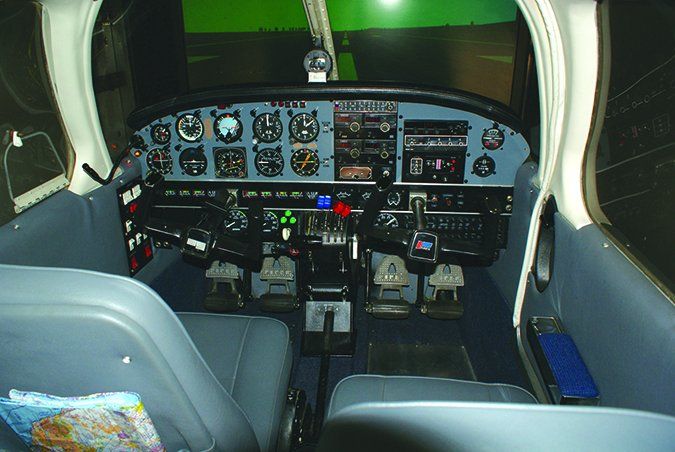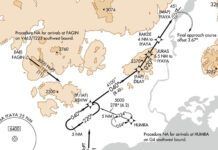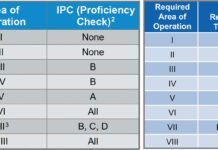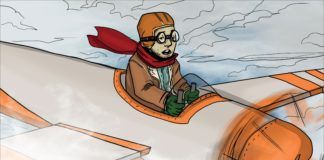Back in the days of steam gauges and conventional VHF nav, you could jump into any aircraft and feel comfortable because everything always worked the same way. It was simple.
But in the age of satellite navigation, electronic instrumentation and multi-function displays with moving maps, each aircraft is different. Just because you can fly an Avidyne Integra-equipped Cirrus doesn’t mean you can jump into a Perspective (a.k.a. Garmin G1000) Cirrus. Or, for that matter, even an old steam-gauge Piper. Now we need proficiency not just on an instrument scan and IFR procedures, but on the installed devices as well.
As flying gets more expensive, maintaining proficiency in the aircraft becomes less attractive. The obvious alternative is a simulator. Plus, a sim can better prepare you for the unexpected because you can actually create the unexpected in the sim far more readily and safely than in an aircraft.
The solution that addresses both ideas isn’t just “a sim.” It’s a cockpit-specific sim that replicates your airplane as accurately as practical. The perfect sim would replicate three things: the aerodynamics of your aircraft; the avionics and related systems (autopilot, digital instruments, and even portable items like an iPad); and the physical locations of buttons switches and knobs. Good visuals, a comfy seat, and a blessing from the FAA would be a plus.
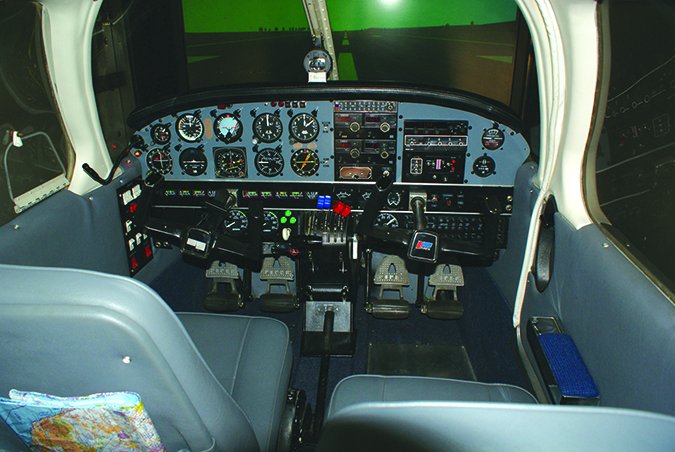
You might get lucky and find a simulator that sufficiently hits all these marks close to home. If so, fly it. A lot. However, the overwhelming odds are that you’d have to purchase such a simulator yourself. Perhaps you could lease it to a local flight school or club, but the more cockpit specific it is, the less it appeals to a broad audience.
Buy your own sim? No, we’re not crazy; you might well find that economically practical, given the need for proficiency and the cost of flying.
What’s a Sim Worth?
Let’s start with some economics. Say you fly a lot. For GA that’s at least 150 hours a year. Interestingly, that’s also where direct operating costs (DOC) start to become meaningful in the face of all the fixed costs.
Let’s assume you fly serious IFR and want to keep your proficiency at a high level. (If not, you can probably go on to the next article.) Your DOC—all in, including reserves, maintenance, depreciation, etc.—are not less than $150/hour and go up to a four-digit expense. We’ll stay at the low end of that spectrum and call it $200/hour for a relatively new, high-performance, piston single.
If you’re truly diligent and spend three hours a month on proficiency, you’re spending $600/month or $7200/year just on practice. Call that your proficiency budget. If you can beat that number—achieve that level of proficiency for less money, or achieve better proficiency for the same cost—you come out ahead in dollars and/or safety. Now that you’ve just justified spending $7200 a year in the name of essential training, let’s go shopping.
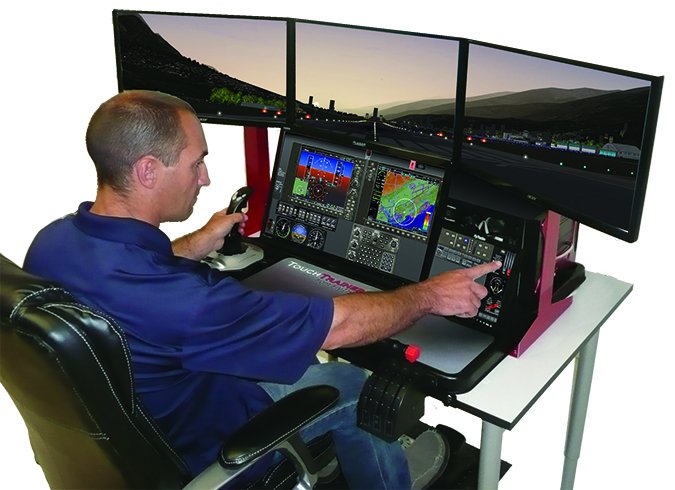
What Matters Most?
Start with what matters most to you. Is it accurate aerodynamics, specific avionics, actual buttonology and procedures for your aircraft, or just general IFR procedures? How important is logging time? We want all of those, but we also need to be practical.
If you need realistic switches and levers in realistic locations, you’ll need a bigger budget. Much bigger. Flight Training Devices (FTDs) put actual avionics, or near-exact replicas thereof, in realistic cockpits. If one of these sims offers a G1000, that’s a real G1000 display. The “Level” simulators at the sim centers and airlines are of this type. These can cost as much as many airplanes (like $250,000 and up). In partnership with a flight school that might work, but it’s not what most of us put in our basement.
Companies like Redbird and Precision Flight Controls (PFC) and even some less expensive Frasca sims offer nearly as much functionality in sims ranging from about $35,000 to $100,000. Instruments and sometimes avionics are depicted on a computer screen, but there’s a physical mask over the screen that looks like an instrument panel and the mask has actual physical controls. This way, each of the basic flight instruments is depicted on screen, and the mask makes it look like separate instruments. Computer rendering of the instruments and avionics lowers the cost, and some systems let you change the mask to change the entire panel and aircraft that’s simulated. So now one sim can represent multiple aircraft.
Back to our “what do you want” checklist: This kind of system does well, but isn’t perfect, on simulating avionics; OK on aerodynamics and feel (some of them have rudimentary motion platforms); and poor on physical switchology. The cost could work in partnership with some other pilots, but you’re still coughing up several years of your training budget. And you need a big enough space to house the thing.
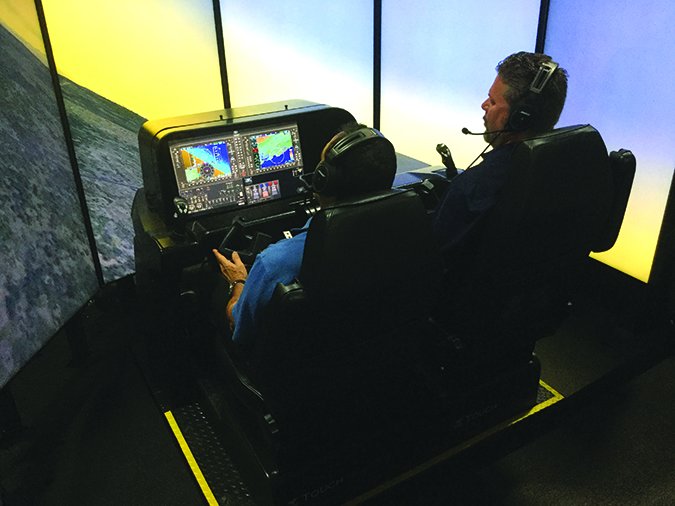
Compromise
The outlook improves if you let go of a few things. Let’s assume you’ll still fly enough in your actual aircraft to practice your exact procedures there, so you don’t need a realistic cockpit. After all, as long as you remember to put the gear down, for instance, does it really matter to your proficiency if the gear switch is in a different place? (Answer: Yes, but not enough to justify much additional cost.)
Let’s also allow that the sim aerodynamics only need to be good enough for realistic power settings during climb, cruise and approach. This is a big help as simulation fidelity is usually best in the middle of the envelope.
We all want to log time in our sim. While that’s desirable if you don’t fly the airplane much and need the sim for legal currency, active GA pilots need the sim for proficiency, not legal currency. Either way, a letter of approval from the FAA shouldn’t necessarily be a high-priority.
This leaves replicating specific avionics and IFR procedures on the list. An interesting company targeting exactly this need is awkwardly called FlyThisSim (FTS).
FTS takes the virtual approach. They have physical flight controls and a power quadrant, but nearly everything else—instruments, avionics, buttons and switches—is depicted on a touchscreen monitor. Yes, even setting the altimeter is done using the touch screen.
This makes buttonology quite unrealistic, but the virtual avionics are faithful to the real thing. The best we’ve seen, in fact. You also get a far broader range of standard models (over 100 aircraft/configurations), plus quite a good library of individual instruments, gauges, controls and avionics that you might be able to use in a customized (more expensive) version to come a lot closer to your actual bird.
Finally, there’s the price. The basic single-screen sim is $5400, and multi-screen setups start at $8100 and go up to $35,000 for some huge, stunning graphics good enough to realistically practice a circle to land (although not FAA approved). These could fit into our training budget. The aerodynamics are decent and you can drive an iPad as if you were actually in flight. It’s even an approved Basic Aviation Training Device, so the FAA says you can log the time and approaches.
This feels like the sweet spot to us. FTS encompasses full operation of the navigator, plus setup and interpretation of the information from the flight instruments (or PFD), and proper use of the autopilot—all in symphonic synchronization to affect the desired outcome. You might not have your exact aircraft or cockpit, but does it really matter to your proficiency if the aerodynamics of your sim replicate a Bonanza instead of a Diamond? Probably not. So long as speeds and power settings are reasonably close, it wouldn’t much impede your proficiency goal. Other operational considerations like where the gear switch or cowl flaps are located probably matter less than keeping the actuation of those controls part of your practice.
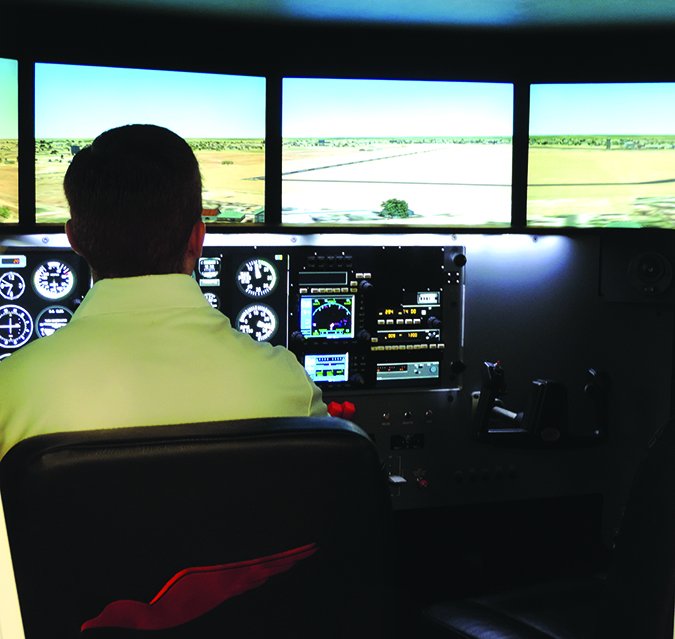
Roll Your Own
Given the power of computers these days, and the seeming abundance of software and flight simulation hardware, building your own realistic flight simulator to match your specific aircraft, systems, and avionics should be a no brainer. Should be, but isn’t.
First, you should only attempt this if you’re 1) good with computer software, 2) good with computer hardware, and 3) patient and persistent enough to get it all to play well together—something that can be the most challenging and frustrating of all.
A flight simulator is a modular system encompassing the computer(s), flight simulation hardware (yoke, rudder pedals, power quadrant, etc.), specific software for the aircraft aerodynamics and performance you want, plug-ins for various options like instruments and avionics, and finally the basic underlying simulation software that ties all this together. Building your own involves selecting various hardware and software components from disparate vendors and integrating them into a working system.
You’ll start with a reasonable gaming PC. Processor power and memory aren’t as critical as a strong graphics card so the graphics run smoothly while the simulator is operating.
You’ll need flight simulation hardware. Fortunately, these tend to interface with the computer using standard and well-supported connections, so getting the hardware to play is usually—but not always—rather straightforward. Also, this is where you must begin to decide the level of fidelity you want and how much you’re willing to pay. Simple consumer-grade controls can be found for a few hundred dollars, but sophisticated systems with control loading can add a zero (or two) to that price tag.
(Control loading is simply varying the amount of force required to move the controls. During a runup in your aircraft, the controls are easy to move. At high-speed, it takes a lot more force. This variability is called control loading.)
The underlying simulation software ties all this stuff together. There are three major simulation software systems—FSX/DFS (formerly Microsoft Flight Simulator), Lockheed Prepar3D (pronounced “Prepared” and abbreviated “P3D”), and X-Plane. Which you chose depends on your other needs.
Avionics and instrument plug ins can be most challenging. Not everything you might want is available, or compatible with other stuff you want—your airframe might only be available on X-plane, but your avionics might only be available on FSX or P3D. No, this stuff is not plug-and-play. (Check out Mindstar and Flight1 for realistic virtual avionics.)
Of course, if you get this far, you don’t want to stop there. You’ll almost certainly want to use your tablet as you do in the airplane. This capability is built into X-Plane, but requires an add-on like FSXFlight to work with FSX or P3D.
For IMC you’ll want realistic weather controls. X-Plane has pretty good weather control built in, but you’ll probably want to add it to FSX or P3D using Active Sky or Rex Weather Architect.
The last step is ATC. If you really want to be on your game, try PilotEdge—a subscription service where you fly with a live controller in virtual SoCal airspace. It’s not as busy as the real thing, but there’s nothing like having a live human being watching your performance to make you actually fly your sim like the real plane, which is really what you’re striving for. PilotEdge can also be integrated into FlyThisSim Touchtrainers, Redbirds, PFC sims and the like.
The bottom line is that it might well be possible to build a suitable simulation of your cockpit in your aircraft, but it’ll likely require extensive research to even find out what’s available and where to compromise, then extensive work to turn it all into a reliable, usable simulator. Your reward for that effort, if the components are available to do what you want, can be a highly personalized simulator for just a few thousand dollars.
Just Do It
Regular exercise means far more than FAA instrument currency; true proficiency means you can handle most anything that could happen in real life. This requires at least a few hours a month—more likely a few hours a week—depending on the complexity of your aircraft and how fast your skills oxidize. Few of us get that much time in our airplanes, thus requiring a sim.
Our perspective is that avionics accuracy and IFR procedures that replicate the flow and patterns of your aircraft are most important. Aerodynamics, physical cockpit locations, and logging are less critical. You decide for yourself.
But whatever you decide is most critical for yourself, form a plan and make that happen.

